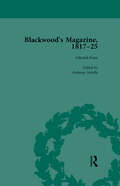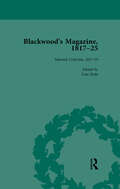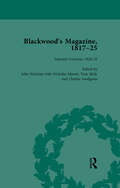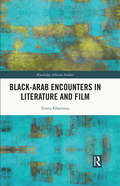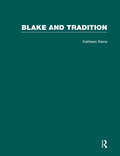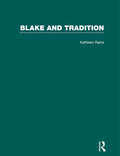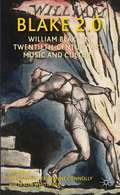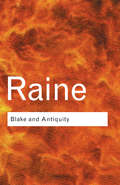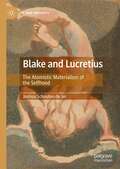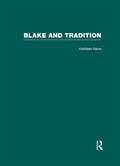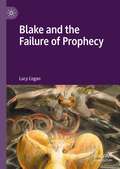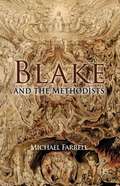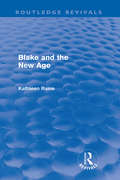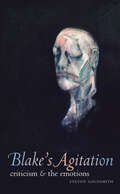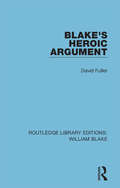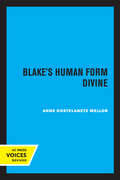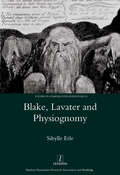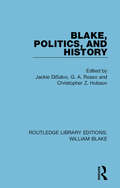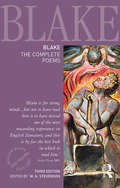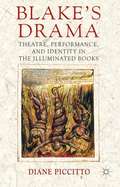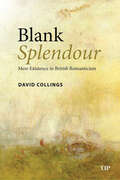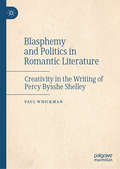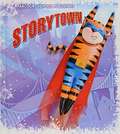- Table View
- List View
Blackwood's Magazine, 1817-25, Volume 2: Selections from Maga's Infancy
by Mark Parker John Strachan Tom Mole Nicholas Mason Anthony JarrellsContextualizes and annotates the influential, scandalous, and entertaining texts which appeared in the Blackwood's Magazine between 1817 and 1825. This title features a detailed general introduction, volume introductions and endnotes, providing the reader with an understanding of the origins and early history of Blackwood's Magazine.
Blackwood's Magazine, 1817-25, Volume 5: Selections from Maga's Infancy
by Mark Parker John Strachan Tom Mole Nicholas Mason Anthony JarrellsContextualizes and annotates the influential, scandalous, and entertaining texts which appeared in the Blackwood's Magazine between 1817 and 1825. This title features a detailed general introduction, volume introductions and endnotes, providing the reader with an understanding of the origins and early history of Blackwood's Magazine.
Blackwood's Magazine, 1817-25, Volume 6: Selections from Maga's Infancy
by Mark Parker John Strachan Tom Mole Nicholas Mason Anthony JarrellsContextualizes and annotates the influential, scandalous, and entertaining texts which appeared in the Blackwood's Magazine between 1817 and 1825. This title features a detailed general introduction, volume introductions and endnotes, providing the reader with an understanding of the origins and early history of Blackwood's Magazine.
Black–Arab Encounters in Literature and Film (Routledge African Studies)
by Touria KhannousThis book investigates how representations of Black Africans have been negotiated over time in Arabic literature and film. The book offers direct readings of a representative selection of primary texts, shedding light on the divergent ways these authors understood race across different genres, including pre-Islamic classical poetry, polemical essays, travel narratives, novels, and films. Starting with the first recognized Black-Arab poet Antara Ibn Shaddad (580 C.E.) and extending right up to the present day, the works examined illuminate the changes in consciousness that attended Black Africans as they negotiated their position in Arab society. In a twist to Edward Said’s Orientalism, the book argues that scholars in the Middle East and North Africa generated a hierarchical representational discourse themselves, one equally predicated on the Self-Other binary. However, it also demonstrates that Arab racial discourse is not a linear rhetoric but changes according to history, political circumstances, and ideologies such as tribal politics, the Shu’ubiyya movement, nationalism, and imperialism. Blacks and Arabs have had tangled relationships that are based not only on race but also on kinship and solidarity due to trade and other types of connections. Challenging fundamental assumptions of Black Diaspora studies and postcolonial studies, this book will be of interest to scholars of the African diaspora, Arabic literature, Middle East studies, and critical race studies.
Blake & Tradition V1 (Routledge Library Editions Ser.)
by Kathleen RaineFirst published in 2002. This is a collection of topics of A.W.Mellon Lectures of fine Arts stemming from 1962 on the works of Blake. This volume looks at Blake’s work in three sections; ‘The Northern Sun’, ‘The Myth of The Soul’ and ‘Zoas of Physical Life’. Includes works such as ‘Tireil’, Blake’s Cupid and Psyche’ and ‘Enion’
Blake & Tradition V2 (Routledge Library Editions Ser.)
by Kathleen RaineFirst published in 2002. This is a collection of topics of A.W.Mellon Lectures of fine Arts stemming from 1962 on the works of Blake. This volume looks at Blake’s work in three discussions; Reason, Perception and ‘What is Man’. Includes poems such as The Tyger, The Ancient Trees and The Sickness of Albion.
Blake 2.0
by Steve Clark Tristanne Connolly Jason WhittakerBlake said of his works, 'Tho' I call them Mine I know they are not Mine'. So who owns Blake? Blake has always been more than words on a page. This volume takes Blake 2. 0 as an interactive concept, examining digital dissemination of his works and reinvention by artists, writers, musicians, and filmmakers across a variety of twentieth-century media.
Blake and Antiquity (Routledge Classics)
by Kathleen RaineBlake was a visionary like no other. To some, like William Wordsworth, the only explanation for the remarkable spiritual world Blake witnessed and brought to life in his books was 'insane genius'. Although such a view persisted well into the twentieth century, this is the pivotal work which challenged that perspective and changed forever our understanding of William Blake's genius, placing him in the esoteric tradition. For many this book will be a revelation; for lovers of Blake it is indispensable.
Blake and Lucretius: The Atomistic Materialism of the Selfhood (The New Antiquity)
by Joshua Schouten de JelThis book demonstrates the way in which William Blake aligned his idiosyncratic concept of the Selfhood – the lens through which the despiritualised subject beholds the material world – with the atomistic materialism of the Epicurean school as it was transmitted through the first-century BC Roman poet and philosopher Lucretius’ De Rerum Natura. By addressing this philosophical debt, this study sets out a threefold re-evaluation of Blake’s work: to clarify the classical stream of Blake’s philosophical heritage through Lucretius; to return Blake to his historical moment, a thirty-year period from 1790 to 1820 which has been described as the second Lucretian moment in England; and to employ a new exegetical model for understanding the phenomenological parameters and epistemological frameworks of Blake’s mythopoeia. Accordingly, it is revealed that Blake was not only aware of classical atomistic cosmogony and sense-based epistemology but that he systematically mapped postlapsarian existence onto an Epicurean framework.
Blake and Tradition (Routledge Library Editions Ser.)
by Kathleen RaineBlake and Tradition is an investigation of the sources of Blake's knowledge of the Neoplatonic and Hermetic tradition and allied currents of thought. The volumes contain what was then new information on Blake's vast fund of exact knowledge in these fields, and Kathleen Raine interprets his works in the light of the ideas that originally inspired and informed them.The core of this important work of scholarship formed the A. W. Mellon Lectures in the Fine Arts in 1962 at the National Gallery of Art in Washington. The expanded, two-volume work was originally published by Routledge & Kegan Paul in 1969.
Blake and the Failure of Prophecy
by Lucy CoganThis monograph reorients discussion of Blake’s prophetic mode, revealing it to be not a system in any formal sense, but a dynamic, human response to an era of momentous historical change when the future Blake had foreseen and the reality he was faced with could not be reconciled. At every stage, Blake’s writing confronts the central problem of all politically minded literature: how texts can become action. Yet he presents us with no single or, indeed, conclusive answer to this question and in this sense it can be said that he fails. Blake, however, never stopped searching for a way that prophecy might be made to live up to its promise in the present. The twentieth-century hermeneuticist Paul Ricoeur shared with Blake a preoccupation with the relationship between time, text and action. Ricoeur’s hermeneutics thus provide a fresh theoretical framework through which to analyse Blake’s attempts to fulfil his prophetic purpose.
Blake and the Methodists
by Michael FarrellExploring the work of William Blake within the context of Methodism - the largest 'dissenting' religious group during his lifetime - this book contributes to ongoing critical debates surrounding Blake's religious affinities by suggesting that, contrary to previous thinking, Blake held sympathies with certain aspects of Methodism.
Blake and the New Age (Routledge Revivals)
by Kathleen RaineFirst published in 1979, this is a very welcome reissue of Kathleen Raine's seminal study of William Blake - England’s only prophet. He challenged with extraordinary vigour the premises which now underline much of Western civilization, hitting hard at the ideas of a naive materialist philosophy which, even in his own day, was already eating at the roots of English national life. In his insistence that ‘mental things are alone real’, Blake was ahead of his time. Materialist views are now challenged from various quarters; the depth psychologies of Freud and Jung, the study of Far Easter religion and philosophy, the reappraisal of myth and folk lore, the wealth of psychical research have all prepared the way for an understanding of Blake’s thought. We are ready to acknowledge that in attacking ‘the sickness of Albion’ Blake penetrated to the inner worlds of man and explored them in a way that is quite unique. Dr Raine, who has made a long study of Blake’s sources, presents him as a lonely powerful genius who stands within the spiritual tradition of Sophia Perennis, ‘the Everlasting Gospel’. From the standpoint of this great human Norm, our immediate past described by W.B. Yeats as ‘the three provincial centuries’, is a tragic deviation; catastrophic, as Blake believed, in its spiritual and material consequences. Only now do we possess the necessary knowledge to understand William Blake and the ever-growing number of people who turn to him surely justifies his faith in the eternal truths he strove to communicate.
Blake's Agitation: Criticism and the Emotions
by Steven GoldsmithSince the Romantic period, the critical thinker's enthusiasm has served to substantiate his or her agency in the world.Blake’s Agitation is a thorough and engaging reflection on the dynamic, forward-moving, and active nature of critical thought. Steven Goldsmith investigates the modern notion that there’s a fiery feeling in critical thought, a form of emotion that gives authentic criticism the potential to go beyond interpreting the world. By arousing this critical excitement in readers and practitioners, theoretical writing has the power to alter the course of history, even when the only evidence of its impact is the emotion it arouses. Goldsmith identifies William Blake as a paradigmatic example of a socially critical writer who is moved by enthusiasm and whose work, in turn, inspires enthusiasm in his readers. He traces the particular feeling of engaged, dynamic urgency that characterizes criticism as a mode of action in Blake’s own work, in Blake scholarship, and in recent theoretical writings that identify the heightened affect of critical thought with the potential for genuine historical change. Within each of these horizons, the critical thinker’s enthusiasm serves to substantiate his or her agency in the world, supplying immediate, embodied evidence that criticism is not one thought-form among many but an action of consequence, accessing or even enabling the conditions of new possibility necessary for historical transformation to occur. The resulting picture of the emotional agency of criticism opens up a new angle on Blake’s literary and visual legacy and offers a vivid interrogation of the practical potential of theoretical discourse.
Blake's Heroic Argument (Routledge Library Editions: William Blake #2)
by David FullerFirst published in 1988, this book is a study of all Blake’s work in illuminated printing. It traces in particular, the development of his ideas on politics, religion, sexuality, and the imagination. There are substantial sections on some of Blake’s best-known works, including the Marriage of Heaven and Hell, and the Songs of Innocence and Experience, and full critical essays on the Four Zoas and Jerusalem. The book describes the historical contexts of Blake’s work, and sets it in relation to the political controversies of his age as these are reflected in the writings of Burke, Paine and Mary Wollstonecraft. It discusses the relationships of text and design in Blake, the characteristic verbal textures and rhythms of his longer poems, some influences on his thought, and developing structure of his personal myth and its relationship to other mythologies. The opening chapter discusses areas of fundamental disagreement with some of the main approaches to Blake whilst the final chapter discusses literary theory and the practice of criticism, arguing for an open and explicit involvement of personal experience and values and a more creative use of form in critical writing.
Blake's Human Form Divine
by Ann K. MellorThis title is part of UC Press's Voices Revived program, which commemorates University of California Press’s mission to seek out and cultivate the brightest minds and give them voice, reach, and impact. Drawing on a backlist dating to 1893, Voices Revived makes high-quality, peer-reviewed scholarship accessible once again using print-on-demand technology. This title was originally published in 1974.
Blake, Lavater, and Physiognomy
by Sibylle Erle"William Blake never travelled to the continent, yet his creation myth is far more European than has ever been acknowledged. The painter Henry Fuseli introduced Blake to traditional European thinking, and Blake responded to late 18th century body-theory in his Urizen books (1794-95), which emerged from his professional work as a copy-engraver on Henry Hunter's translation of Johann Caspar Lavater's Essays on Physiognomy (1789-98). Lavater's work contains hundreds of portraits and their physiognomical readings. Blake, Fuseli, Joshua Reynolds and their contemporaries took a keen interest in the ideas behind physiognomy in their search for the right balance between good likeness and type in portraits. Blake, Lavater, and Physiognomy demonstrates how the problems occurring during the production of the Hunter translation resonate in Blake's treatment of the Genesis story. Blake takes us back to the creation of the human body, and interrogates the idea that 'God created man after his own likeness.' He introduces the 'Net of Religion', a device which presses the human form into material shape, giving it personality and identity. As Erle shows, Blake's startlingly original take on the creation myth is informed by Lavater's pursuit of physiognomy: the search for divine likeness, traced in the faces of their contemporary men."
Blake, Politics, and History (Routledge Library Editions: William Blake #Vol. 17)
by Jackie DiSalvo G. A. Rosso Christopher Z. HobsonFirst published in 1998, this book formed part of an ongoing effort to restore politics and history to the centre of Blake studies. It adopts a three pronged approach when presenting its essays, seeking to promote a return to the political Blake; to deepen the understanding of some of the conversations articulated in Blake’s art by introducing new, historical material or new interpretations of texts; and to highlight differing perspectives on Blake’s politics among historically focused critics. The collection contains essays with varying methodological assumptions and differing positions on questions central to historicist Blake scholarship.
Blake: The Complete Poems (Longman Annotated English Poets)
by W. H. StevensonWilliam Blake (1757 - 1827) is one of the great figures in literature, by turns poet, artist and visonary. Profoundly libertarian in outlook, Blake's engagement with the issues of his day is well known and this - along with his own idiosynratic concerns - flows through his poetry and art. Like Milton before him, the prodigality of his allusions and references is little short of astonishing. Consquently, his longer viosnary poems can challege the modern reader, who will find in this avowedly open edition all they might need to interpret the poetry. W. H. Stevenson's Blake is a masterpiece of scrupulous scholarship. It is, as the editor makes clear in his introduction, 'designed to be widely, and fluently, read' and this Third Edition incorporates many changes to further that aim. Many of the headnotes have been rewritten and the footnotes updated. The full texts of the early prose tracts, All Religions are One and There is no Natural Religion, are included for the first time. In many instances, Blake's capitalisation has been restored, better to convey the expressive individuality of his writing. In addition, a full colour plate section contains a representation of Blake's most significant paintings and designs. As the 250th anniversary of his birth approaches, Blake has perhaps more readers than ever before; Blake: The Complete Poems will stand those readers, new and old, in good stead for many years to come.
Blake’s Drama
by Diane PiccittoBlake's Drama challenges conventional views of William Blake's multimedia work by reinterpreting it as theatrical performance. Viewed in its dramatic contexts, this art form is shown to provoke an active spectatorship and to depict identity as paradoxically essential and constructed, revealing Blake's investments in drama, action, and the body.
Blank Splendour: Mere Existence in British Romanticism
by David CollingsCertain moments in British Romantic poetry and art depict a state from which the attributes of existence – time and space, subject and object, language and visuality – have fallen away, leaving a domain prior to the world and to thought, the condition of mere existence. As Blank Splendour demonstrates, poems by Wordsworth, Coleridge, Keats, and Clare as well as paintings by Turner evoke a condition that transpires in a time without time, a life without life. David Collings argues that these works invite us to move beyond the subtle remnants of ontology that linger in current versions of posthuman thought, such as affect theory and speculative realism, by opening up a domain of affect without affect, a world without objects. Anticipating the philosophers Emmanuel Levinas and Maurice Blanchot, these works bring into view the mode of a deconstruction that emerged before the linguistic turn, one that meditates on the blank condition underlying modernity. Ultimately, Blank Splendour reveals how these works speak to our own moment, when thought, forced to contemplate its own extinction, enters a new form of mere existence.
Blasphemy and Politics in Romantic Literature: Creativity in the Writing of Percy Bysshe Shelley
by Paul WhickmanThis book argues for the importance of blasphemy in shaping the literature and readership of Percy Bysshe Shelley and of the Romantic period more broadly. Not only are perceptions of blasphemy taken to be inextricable from politics, this book also argues for blasphemous ‘irreverence’ as both inspiring and necessitating new poetic creativity. The book reveals the intersection of blasphemy, censorship and literary property throughout the ‘Long Eighteenth Century’, attesting to the effect of this connection on Shelley’s poetry more specifically. Paul Whickman notes how Shelley’s perceived blasphemy determined the nature and readership of his published works through censorship and literary piracy. Simultaneously, Whickman crucially shows that aesthetics, content and the printed form of the physical text are interconnected and that Shelley’s political and philosophical views manifest themselves in his writing both formally and thematically.
